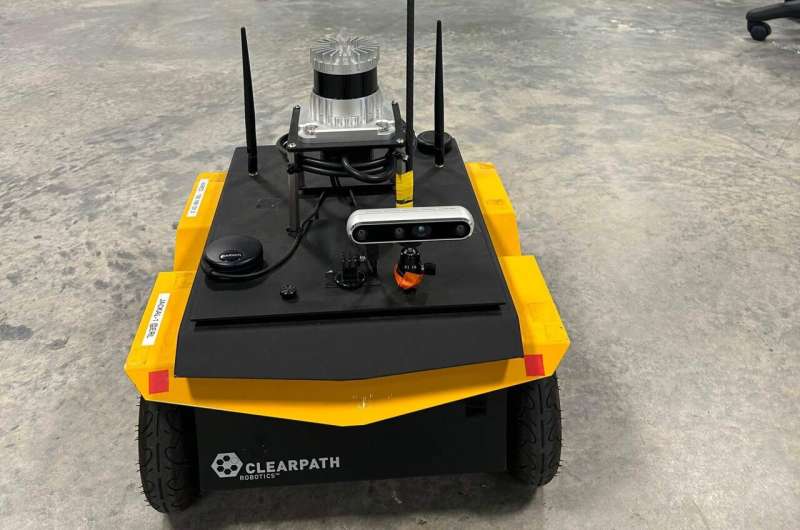June 21, 2024 feature
This article has been reviewed according to Science X's editorial process and policies. Editors have highlighted the following attributes while ensuring the content's credibility:
fact-checked
preprint
trusted source
proofread
A method to enable safe mobile robot navigation in dynamic environments

To successfully complete missions in dynamic and unstructured real-world environments, mobile robots should be able to adapt their actions in real-time to avoid collisions with nearby objects, people or animals.
Most existing approaches to prevent robot collisions work by creating accurate maps of the environment a robot is navigating and then planning the best trajectories to safely reach a desired location.
Many previously proposed robot navigation techniques have achieved promising results in simulation. However, they often did not perform as well in real-world environments, particularly those that are unpredictable and rapidly changing over time.
Researchers at University of California, San Diego recently introduced a new method that could enhance the navigation of mobile robots in dynamic and unstructured environments.
This method, introduced in a paper posted to the arXiv preprint server, has so far been successfully applied to the Jackal robot, a wheeled robotic system developed by ClearPath Robotics.
"Our recent paper addresses the critical need for safe autonomous navigation of mobile robots in complex, unknown and dynamic environments, while considering the limited sensing and computational resources available onboard," Kehan Long, co-author of the paper, told Tech Xplore.
"While previous research has made significant advances using techniques such as artificial potential fields, navigation functions, and control barrier functions, many of these methods rely on constructing an accurate map of the environment."
Building maps of dynamic environments in real-time can be challenging, particularly if these environments rapidly change over time. The key objective of the recent study by Long and his colleagues was to develop a new method that can guarantee the safety of mobile robots in these changing environments, directly leveraging data collected by a robot's onboard sensors instead of reconstructing precise maps of the environment.
"Our novel method for safe mobile robot navigation introduces a distributionally robust control barrier function (DR-CBF) formulation," Long explained.
"The core concept is to directly incorporate the robot's noisy range sensor measurements (e.g., from LiDAR) into the control optimization as safety constraints, rather than first constructing an accurate map. By employing rigorous theories from distributionally robust optimization, we can robustly account for uncertainties in both sensing and the dynamic environment."
The mobile robot navigation method developed by Long and his colleagues has various advantages over other approaches introduced over the past few years. Most notably, it can guarantee the safe operation of robots, preventing them from colliding with objects, while only requiring limited computational resources.
"A distinctive feature of our method is that it ensures safe navigation by directly utilizing recent sensor data in determining the control input, enabling the robot to swiftly adapt to environmental changes," Long said.
"The practical implications of our work are significant. By enabling the development of reliable mobile robots with reduced computational requirements, our approach has the potential to lower the cost of building robots, making them more accessible for a wide range of applications."
To test their method, Long and his colleagues applied it to the ClearPath Jackal, a wheeled weatherproof robot, which was equipped with a LiDAR sensor. Their findings were encouraging, demonstrating the effectiveness and versatility of their approach in both indoor and outdoor dynamic settings.
"In our future research, we plan to extend our methodology to more complex robotic systems, such as legged robots and humanoids," Long added. "Our ultimate goal is to develop safe and capable robots that can navigate and interact in any environment while providing robust safety guarantees."
More information: Kehan Long et al, Sensor-Based Distributionally Robust Control for Safe Robot Navigation in Dynamic Environments, arXiv (2024). DOI: 10.48550/arxiv.2405.18251
existentialrobotics.org/DR_Saf … _Navigation_Webpage/
© 2024 Science X Network



















